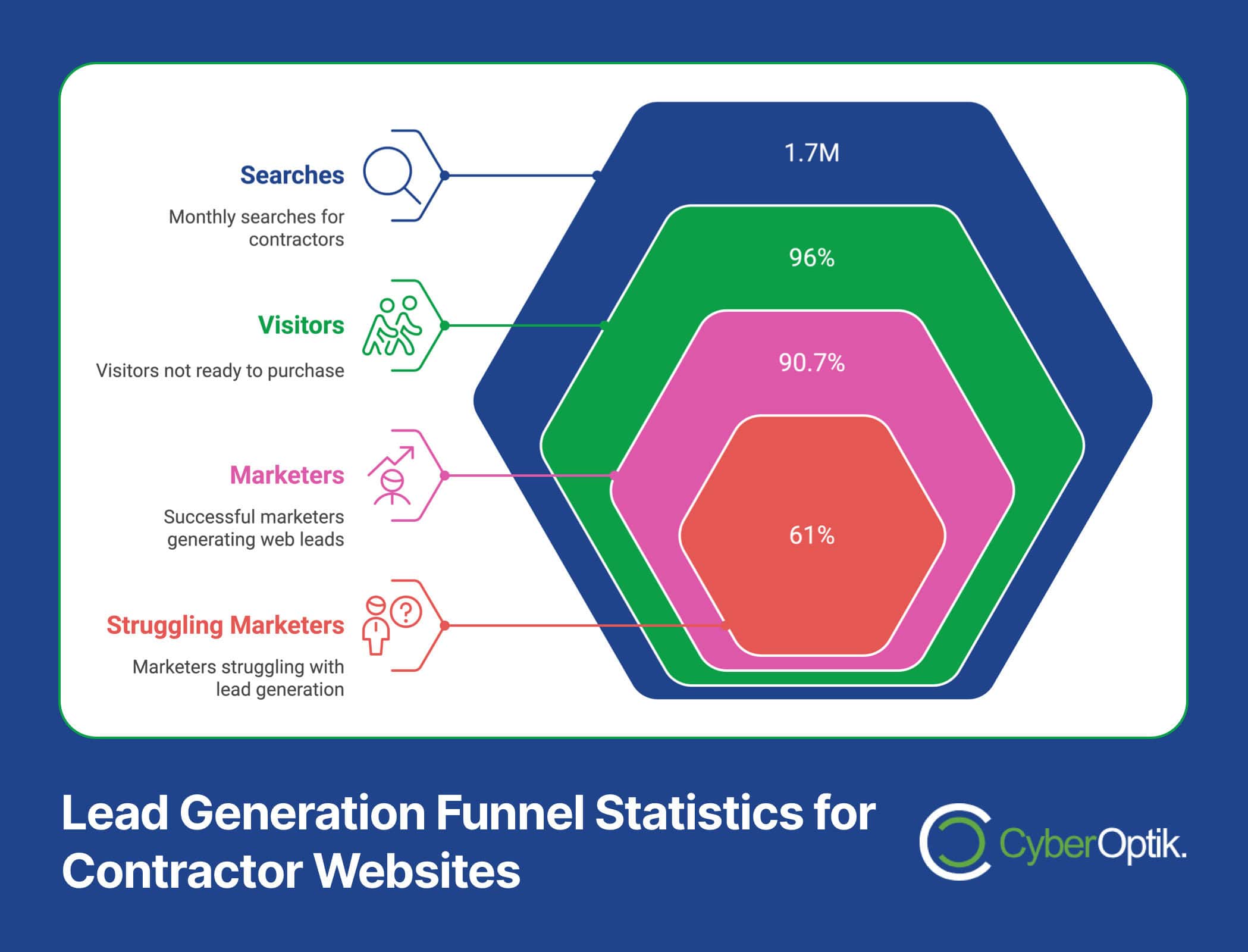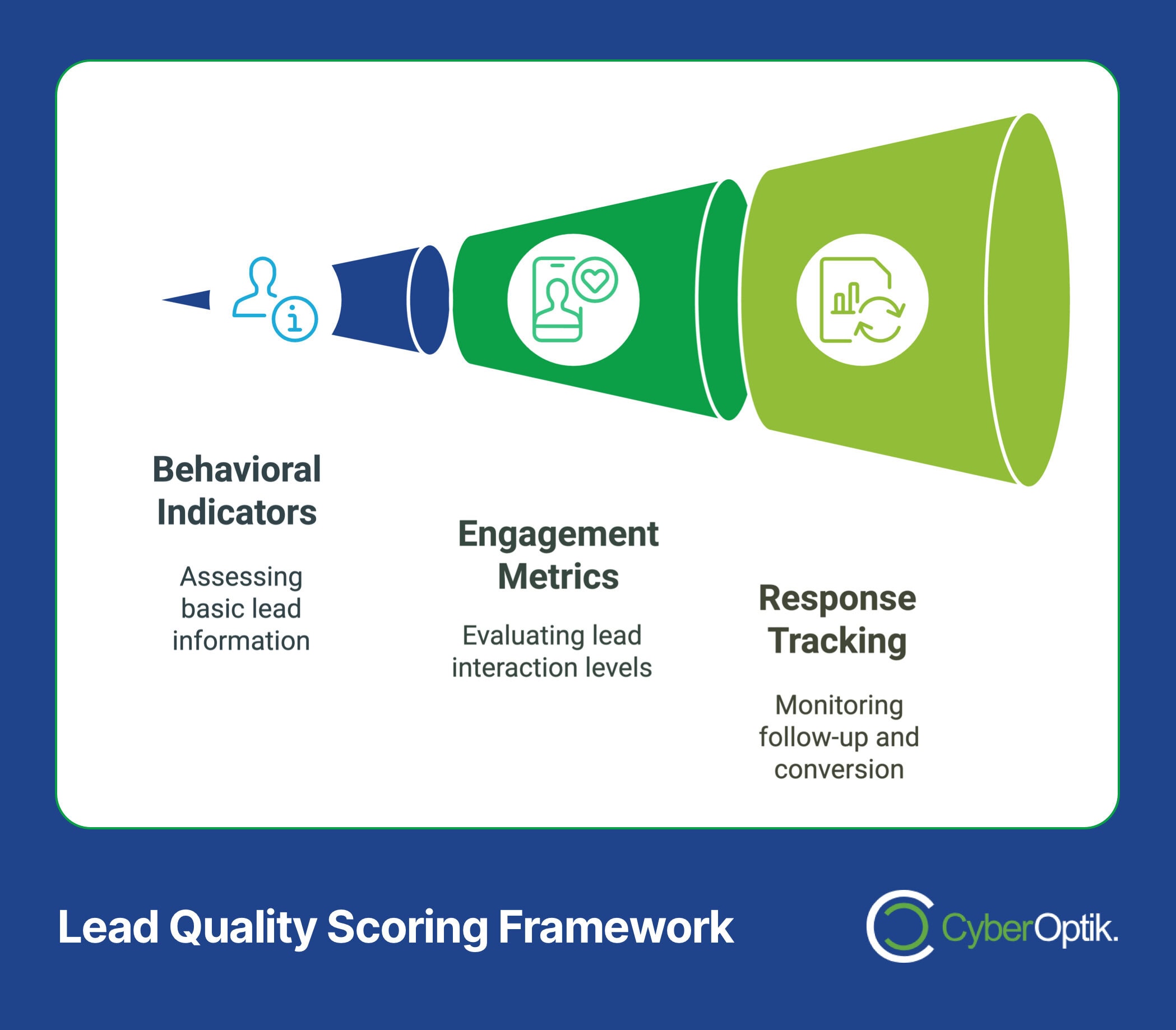Your contractor website holds untapped potential as a lead generation powerhouse. With 1.7 million monthly online searches for independent contractors, the opportunity for growth through digital channels has never been greater (Source: WebFX). We’ve discovered that most contractors struggle with website conversion, leaving significant revenue on the table while their competitors capture valuable leads around the clock.
Through our work with construction businesses across Chicago, we’ve identified a clear pattern: websites that merely showcase services no longer meet the demands of today’s digital-first customers. Your website must evolve from a static brochure into an active lead-generation engine that works tirelessly to convert visitors into qualified leads.
This guide provides proven strategies to transform your contractor website into a powerful lead generation system. We’ll share specific techniques that have helped our clients achieve consistent lead flow, backed by real data and practical implementation steps. By focusing on these core strategies, you’ll build a digital presence that actively contributes to your business growth.
The Current State of Contractor Websites

Most contractor websites fail to generate leads because they ignore a crucial reality: 96% of website visitors aren’t ready to make an immediate purchase (Source: WebFX). This statistic reveals why traditional “brochure-style” websites consistently underperform. Your potential clients need more than just service listings and contact information to convert into qualified leads.
A solid digital marketing strategy begins with understanding why most contractor websites struggle to generate leads. The primary issues we’ve identified through our work with construction businesses include poor user experience, lack of clear calls-to-action, and insufficient lead capture mechanisms.
Key Performance Indicators for Contractor Websites
The performance gap between high-converting contractor websites and those that struggle becomes clear when examining specific metrics. Successful contractor websites consistently demonstrate higher engagement rates, longer time on page, and most importantly, better conversion rates. These metrics directly correlate with the website’s ability to generate qualified leads.
Our analysis shows that successful contractor websites share several critical characteristics. They provide valuable content that addresses specific customer pain points, offer multiple contact options, and implement automated lead nurturing systems. These elements work together to create a consistent flow of qualified leads, even outside regular business hours.
The distinction between a website that generates leads and one that doesn’t often comes down to strategic implementation of key features. By understanding these elements and how they work together, you can begin transforming your website into an effective lead generation tool. The next section will detail the essential components required to build a website that consistently attracts and converts potential clients.
Essential Components of a Lead Generation Website
A high-performing contractor website requires specific components working in harmony to generate leads consistently. The data supports this approach, with 90.7% of successful marketers generating leads through their websites (Source: WiserNotify). We’ve identified the core elements that transform static websites into lead generation engines through our experience with numerous contractor clients.
Professional Design Elements
Professional design serves as the foundation of your lead generation efforts. Your website must instantly convey trust and competence while guiding visitors toward conversion actions. We’ve found that effective contractor websites incorporate clear navigation structures, prominent calls-to-action, and compelling project galleries that showcase your expertise.
Mobile optimization plays a crucial role in lead generation success. Many potential clients search for contractors during job site visits or while discussing projects with stakeholders. Your website must deliver a seamless experience across all devices, maintaining quick loading times and easy navigation regardless of screen size.
Lead Capture Systems
Implementing effective remarketing strategies and lead capture systems transforms casual visitors into qualified leads. Strategic placement of contact forms, integration of live chat functionality, and implementation of call tracking systems create multiple conversion opportunities throughout the user journey.
The most effective lead capture systems include:
- Multi-step contact forms that qualify leads while maintaining high conversion rates
- AI-powered chatbots that engage visitors 24/7 and schedule consultations
- Click-to-call buttons prominently displayed on mobile devices
- Project estimate calculators that provide immediate value while capturing contact information
- Emergency service request forms for urgent needs
Each of these components must work together seamlessly to create a frictionless lead generation process. The key lies in balancing user experience with data collection, ensuring visitors receive value while providing the information you need to nurture them into qualified leads.
While these essential components form the backbone of your lead generation website, their effectiveness depends on proper optimization and ongoing refinement. The next section will explore specific optimization strategies that maximize the performance of these elements, ensuring your website consistently generates high-quality leads.
Optimization Strategies
Effective optimization transforms good websites into exceptional lead generation engines. Our data shows that 60% of successful marketers rely on inbound marketing techniques to generate high-quality leads (Source: Salesmate.io). This section outlines the proven optimization strategies that maximize your website’s lead generation potential.
SEO for Contractors
Search engine optimization forms the foundation of sustainable lead generation for contractors. Your potential clients actively search for specific services in your area, and proper SEO ensures your website appears when these searches occur. We focus on three critical areas of SEO optimization for contractor websites.
Local search optimization plays a crucial role in attracting nearby clients. This includes optimizing your Google Business Profile, creating location-specific service pages, and building local citations. These elements work together to improve your visibility in local search results, where many potential clients begin their contractor search.
Content strategy drives organic traffic and establishes your expertise. Creating detailed content about specific services, project types, and common customer questions serves multiple purposes. It helps your website rank for valuable keywords while providing the information potential clients need to make informed decisions.
Conversion Rate Optimization
Strategic retargeting campaigns and conversion optimization transform website traffic into qualified leads. This process involves continuous testing and refinement of key website elements to maximize conversion rates. Our approach focuses on data-driven improvements that directly impact lead generation.
The most effective conversion optimization elements include:
- Strategic placement and design of call-to-action buttons
- Optimization of form fields and submission processes
- Implementation of social proof and trust signals
- Creation of targeted landing pages for specific services
- Development of compelling lead magnets and offers
A/B testing plays a vital role in conversion optimization. By systematically testing different elements of your website, we identify the combinations that generate the highest conversion rates. This data-driven approach ensures continuous improvement in lead generation performance.
The optimization process never truly ends, as there’s always room for improvement in website performance. However, implementing these strategies creates a solid foundation for consistent lead generation. The next section will explore how automation and integration streamline the lead capture process, ensuring no opportunities slip through the cracks.
Automation and Integration
Speed and efficiency in lead response make the difference between winning and losing potential clients. Research shows that contacting leads within 30 seconds improves conversion rates by 90% (Source: CallPage.io). Automation and integration systems ensure your website captures and processes leads effectively, even outside business hours.
Marketing Automation Tools
Reliable website hosting combined with marketing automation creates a robust foundation for lead generation. These systems work tirelessly to nurture leads through the sales funnel, providing immediate responses to inquiries and maintaining engagement throughout the decision-making process.
Marketing automation handles crucial tasks such as sending immediate confirmation emails, scheduling follow-up messages, and distributing leads to your sales team. This systematic approach ensures no lead goes unnoticed while maintaining consistent communication with potential clients.
Lead Management Systems
Effective lead management requires sophisticated systems that qualify and distribute leads based on specific criteria. Our experience shows that contractors benefit most from systems that automatically categorize leads based on project type, budget range, and urgency level.

Key automation components that enhance lead management include:
- Automated lead scoring based on behavior and engagement
- Instant notification systems for urgent service requests
- Custom workflow triggers for different service categories
- Integration with CRM systems for seamless lead tracking
- Automated follow-up sequences for different lead types
The integration of these systems creates a seamless flow from initial contact to qualified lead. Each component plays a specific role in nurturing potential clients, ensuring they receive relevant information and timely responses throughout their journey.
Proper implementation of automation and integration systems transforms your website into a true 24/7 lead generation engine. These tools handle the technical aspects of lead capture and nurturing, allowing you to focus on providing excellent service to your clients. The next section will explore how to measure and track the success of these systems, ensuring your lead generation efforts continue to improve over time.
Measuring Success
Effective measurement of your website’s lead generation performance guides continuous improvement. With 61% of marketers identifying lead generation as their primary challenge (Source: Blue Corona), tracking the right metrics becomes crucial for success.
Key Metrics to Monitor
Understanding your website impression data and conversion metrics provides insights into your lead generation effectiveness. We focus on specific performance indicators that directly impact lead generation success for contractor websites.
The most valuable metrics for contractor websites include conversion rates by source, cost per lead, lead quality scores, and response time measurements. These data points reveal the effectiveness of your lead generation systems and highlight areas for improvement.
| Metric Category | What to Track | Why It Matters |
|---|---|---|
| Traffic Quality | Bounce Rate, Time on Site, Pages per Visit | Indicates visitor engagement and content relevance |
| Conversion Performance | Form Submissions, Call Tracking, Chat Interactions | Measures lead capture effectiveness |
| Lead Quality | Qualification Rate, Project Value, Close Rate | Determines ROI and system efficiency |
Regular analysis of these metrics enables data-driven decisions about website improvements and marketing strategies. This systematic approach to measurement ensures your lead generation efforts continue to deliver increasing value over time.
Continuous Improvement
Success in lead generation requires an ongoing commitment to optimization and refinement. Our approach involves regular testing of new features, analysis of user behavior, and implementation of improvements based on performance data.
The continuous improvement cycle includes regular review of:
- User journey analysis to identify conversion barriers
- A/B testing results for form designs and CTAs
- Lead quality feedback from sales teams
- Performance comparisons against industry benchmarks
- ROI calculations for different lead sources
This data-driven approach to improvement ensures your website consistently performs at its peak potential for lead generation. By monitoring these metrics and making informed adjustments, your website becomes increasingly effective at converting visitors into qualified leads.
With a clear understanding of how to measure and improve your website’s performance, the next section will provide a practical implementation guide for transforming your website into a lead generation engine. This roadmap will help you prioritize improvements and achieve quick wins while building toward long-term success.
Implementation Guide
Transforming your website into a lead generation engine requires a systematic approach. Content marketing generates 54% more leads than traditional marketing methods (Source: WebFX). Our proven web design process helps contractors implement these changes effectively while maintaining business operations.
The implementation process begins with a comprehensive audit of your current website performance. This assessment identifies quick wins and long-term improvements needed to maximize lead generation potential. We prioritize changes that deliver immediate impact while building toward sustainable growth.
Your implementation roadmap should follow this proven sequence:
- Week 1-2: Technical foundation optimization and analytics setup
- Week 3-4: Lead capture system implementation and form optimization
- Week 5-6: Content development and SEO enhancement
- Week 7-8: Automation system integration and testing
- Week 9-10: Staff training and process refinement
Each phase builds upon the previous improvements, creating a comprehensive lead generation system. This structured approach ensures proper implementation while minimizing disruption to your daily operations.
Resource Allocation
Successful implementation requires appropriate allocation of resources and responsibilities. Your team needs clear ownership of specific tasks while maintaining focus on core business activities. We recommend designating a primary point person to coordinate with technical teams and manage the implementation timeline.
Budget considerations should account for both immediate needs and ongoing optimization. While initial setup requires more resources, maintaining and improving your lead generation system becomes more cost-effective over time as automation reduces manual effort and increases efficiency.
The success of your implementation depends on commitment to the process and willingness to make data-driven adjustments. Regular review meetings help track progress and address any challenges that arise during implementation. This collaborative approach ensures your website transformation stays on track and delivers the expected results.
With the implementation roadmap established, you likely have specific questions about the process and expected outcomes. The following FAQ section addresses the most common questions we receive from contractors about website lead generation transformation.
Frequently Asked Questions
Contractors often have specific concerns about transforming their websites into lead generation engines. Understanding that 62% of customers will ignore businesses without an effective web presence (Source: WebFX), we’ve compiled answers to the most common questions about website lead generation.
How long until I see results from website improvements?
Initial improvements in lead generation typically appear within the first 30 days after implementation. These early results often come from optimized contact forms and improved call-to-action placement. Full optimization of website referral traffic and organic search performance usually takes 3-6 months to reach its potential.
What kind of ROI should I expect from website lead generation?
Return on investment varies based on your service offerings and average project value. Most contractors see positive ROI within the first quarter after implementation. Our clients typically experience a 2-4x return on their investment within the first year, with ROI increasing as systems become more refined.
How much time will I need to dedicate to managing the system?
After initial setup and training, most contractors spend 2-3 hours per week monitoring and adjusting their lead generation systems. Automation handles the majority of tasks, allowing you to focus on responding to qualified leads and serving your clients.
What distinguishes high-quality leads from low-quality ones?
Quality leads demonstrate specific characteristics: they provide complete contact information, describe their project requirements clearly, and fall within your target service area. Our lead scoring system helps identify the most promising opportunities based on these and other relevant factors.
How do you maintain lead generation during slow seasons?
Seasonal fluctuations affect all contractors, but effective lead generation systems help maintain a steady flow of opportunities. Strategic content marketing, targeted advertising, and automated nurture campaigns keep your pipeline full even during traditionally slower periods.
These answers address common concerns, but every contractor’s situation is unique. Your specific needs may require customized solutions based on your market, services, and business goals. The conclusion will summarize key actions you can take to begin your website transformation journey.
Conclusion
Your contractor website holds untapped potential as a powerful lead generation engine. Throughout this guide, we’ve outlined the essential components, strategies, and implementation steps needed to transform your online presence into a consistent source of qualified leads.
Success in website lead generation comes from the systematic implementation of proven strategies. Professional design, effective lead capture systems, strategic optimization, and proper automation create a foundation for sustainable growth. These elements work together to attract, engage, and convert potential clients around the clock.
The transformation process requires commitment and attention to detail, but the results justify the investment. A properly optimized website continues generating leads long after implementation, providing a reliable pipeline of opportunities for your contracting business.
Next Steps
Begin your website transformation by conducting a thorough assessment of your current online presence. Identify quick wins that can immediately improve lead generation while planning for long-term optimization. Remember that each improvement builds upon previous successes, creating compound growth in lead generation effectiveness.
We understand the challenges contractors face in generating consistent, quality leads. Our team specializes in helping contractors like you implement these proven strategies. Contact us today to discuss how we can help transform your website into a powerful lead generation engine that drives sustainable business growth.




